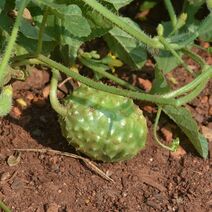Cucumis anguria
| Cucumis anguria | |
 | |
| Light: | |
| Moisture: | |
| Hardiness: | 10 |
| Soil pH: | 5.6-8.4 |
| Self Pollinated | |
| Height: | 8' |
| Blooms: | Mid Summer-Early Fall |
| Edible Rating: | |
| Medicinal Rating: | |
| Tea: | Yes |
Cucumis anguria (common name: gherkin)
Propagation: Seed - sow early to mid spring in a greenhouse in a rich soil. Germination should take place within 2 weeks. Sow 2 or 3 seeds per pot and thin out to the best plant. Grow them on fast and plant out after the last expected frosts, giving them cloche or frame protection for at least their first few weeks if you are trying them outdoors.
Cultivation: Requires a rich, well-drained moisture retentive soil and a very warm, sunny and sheltered position.
A frost-tender annual plant, the gherkin is frequently cultivated for its fruit in warm temperate and tropical areas of the world, but it only really succeeds in Britain when grown under protection[1]. There are many named varieties.
Range: Probably originated in Tropical America but not known in a truly wild condition. Possibly a cultigen
Habitat: Not known in the wild.
Edibility: Fruit - raw, cooked or pickled[2][3][4][5][6]. A very agreeable cucumber flavour without any bitterness[7][K]. It can be used in salads or as part of a savoury dish. The fruit is frequently soaked in vinegar to make a pickle, it absorbs a large quantity of vinegar[7]. The fruit is up to 5cm long and 4cm wide[1].
Seed - raw. Rich in oil with a nutty flavour but very fiddly because it is rather small and covered with a fibrous seedcoat[8][9][K].
Medicinal: The seeds are vermifuge[11]. They are ground into a fine flour, then made into an emulsion with water and eaten. It is then necessary to take a purge in order to expel the tapeworms or other parasites from the body[11].
Pollinators: Insects
Soil: Can grow in light, medium, and heavy soils.
Drainage: Prefers well drained soil.
Seed Ripens: Late Summer-Mid Fall
Flower Type: Monoecious
Known Hazards: The sprouting seed produces a toxic substance in its embryo[12].
Links
References
- ↑ 1.0 1.1 Huxley, Anthony. The New Royal Horticultural Society Dictionary of Gardening. MacMillan Press, 1992.
- ↑ Chittendon, Fred. RHS Dictionary of Plants. Oxford University Press, 1951.
- ↑ Hedrick, Ulysses. Sturtevant's Edible Plants of the World. Dover Publications, 1972.
- ↑ Vilmorin-Andrieux. The Vegetable Garden. Ten Speed Press.
- ↑ Uphof, Johannes. Dictionary of Economic Plants. Weinheim, 1959.
- ↑ Usher, George. A Dictionary of Plants Used by Man. Constable, 1974.
- ↑ 7.0 7.1 7.2 Facciola, Stephen. Cornucopia - A Source Book of Edible Plants. Kampong Publications, 1990.
- ↑ Schery. Robert. Plants for Man. Prentice Hall, 1972.
- ↑ Organ, John. Gourds. Faber, 1963.
- ↑ Kunkel, Günther. Plants for Human Consumption. Koeltz Scientific Books, 1984.
- ↑ 11.0 11.1 Chiej, Roberto. Encyclopaedia of Medicinal Plants. MacDonald, 1984.
- ↑ Frohne, Dietrich and Hans Pfänder. J. A Colour Atlas of Poisonous Plants. Timber Press, 1984.